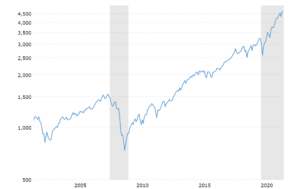You might wonder if you can take on the risk involved with investing. You certainly shouldn’t invest in anything you’re not comfortable with, and this blog isn’t meant to offer investment advice. But, it’s important to understand the nature of 4 common investment risks and how to mitigate them.
Before we start, let’s define an investment. Generally, a financial investment is anything you put money into to make a profit–typically through receiving income or making a capital gains (see our blog on What Is an Investment?) over time. Today, we’ll focus on liquid investments like stocks and bonds.
Investment Risk #1: Poor Investment Timing
Generally, the value of stocks and bonds increase over the long term, but daily values fluctuate. You don’t want to be caught having to sell investments at a low price to fund an emergency. To avoid that situation, before funding an investment portfolio, keep the following amounts in cash:
- Emergency fund of 6 to 12 months of expenses to cover needs in case of a job loss or a short-term emergency. See our blog Cash is more than Defense.
- Cash needed for goals you aim to achieve within the next 5 years. Only invest cash you don’t need for 5 or more years, and as you get closer to a goal, reallocate investments steadily so you have the cash needed when it’s time to fund the goal.
Another way to mitigate timing risk is to invest steadily over time. For example, if you have $500 extra to invest every month, rather than letting it accumulate and investing a large amount at once, make $500 contributions to your investment account monthly. This strategy, called, dollar-cost averaging, allows you to invest regularly as the markets fluctuate.
Investment Risk #2: Investing Too Aggressively
From a day-to-day basis, markets are unpredictable. However, over the long run, stock and bond markets tend to increase in value. This stock chart from Macrotrends shows the short-term fluctuations of the S&P 500, which represents stocks of the largest US companies, over a path of long-term growth.

Source: Macrotrends
If you’re investing funds you need a few years from now, you should invest less aggressively than if you need the funds decades from now. As your time horizon decreases, rebalance from a more aggressive portfolio to a more conservative one. Investment portfolios with a larger concentration of stocks tend to be more aggressive than those with a larger concentration of bonds and cash.
For example, if you begin contributing to your retirement account in your 20’s, you can afford to invest more aggressively than if you begin contributing in your 50’s. As you approach retirement, rebalance your portfolio so that it’s less aggressively invested. The next section discusses how to decrase risk in your portfolio.
Investment Risk #3: Being Too Concentrated
Each specific investment has its own risks as well. If you buy stock in one company, you take on that company’s risks. Poor management, an unexpected competitor, issues with supply and many other factors can affect that company’s performance. The same is true of bonds. If you buy a bond in a company that faces unforeseen financial difficulty, your investment could decrease in value.
For that reason, it’s best to diversify your investment portfolio. When you diversify, you invest in different types of investments. Instead of investing in one company’s stock, you spread your money (and therefore your risk) over many companies’ stocks. You could also invest a portion of your money in an array of stocks and bonds. You could diversify by investing in companies around the world rather than in one country. All of these are ways to diversify, and there are many others.
A common way to diversify is to invest in mutual funds. A mutual fund pools many investors’ money in order to access a wider array of investments than one person could access on their own. This allows investors to diversify even if they have a small amount to invest.
Investment Risk #4: Misunderstanding Your Risk Tolerance
We discussed the fact that markets fluctuate on a daily basis, and sometimes, they will fluctuate quite a bit in a short period of time. Each of us has a unique risk tolerance, which determines the amount of volatility we can tolerate. If you’re invested too aggressively, you might be tempted to sell your investments on a day the market declines. If you’re regularly concerned about your investment portfolio or if it is “keeping you up at night,” that’s a sign you should consider investing more conservatively. Selling out of fear will reduce the benefits of long-term investing, and it’s best to maintain a portfolio that you’re comfortable with from the start.
We’ve detailed 4 main investments risks that you can mitigate with a long-term outlook, investing steadily over time, and understanding your own comfort-level with the investment markets. An investment advisor can help you determine the right investment portfolio to meet your individual goals.

